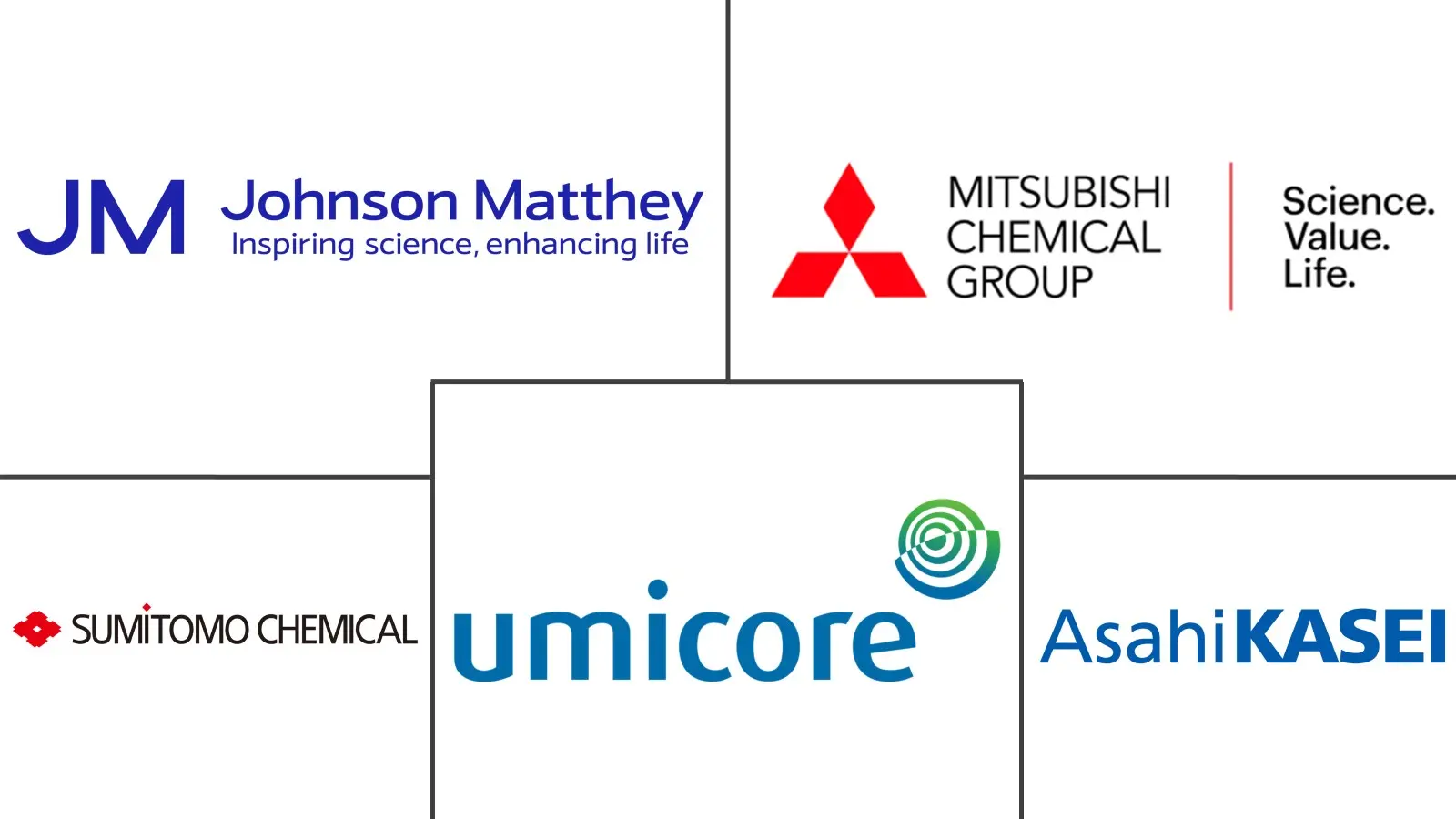Battery Raw Material Market Size and Share
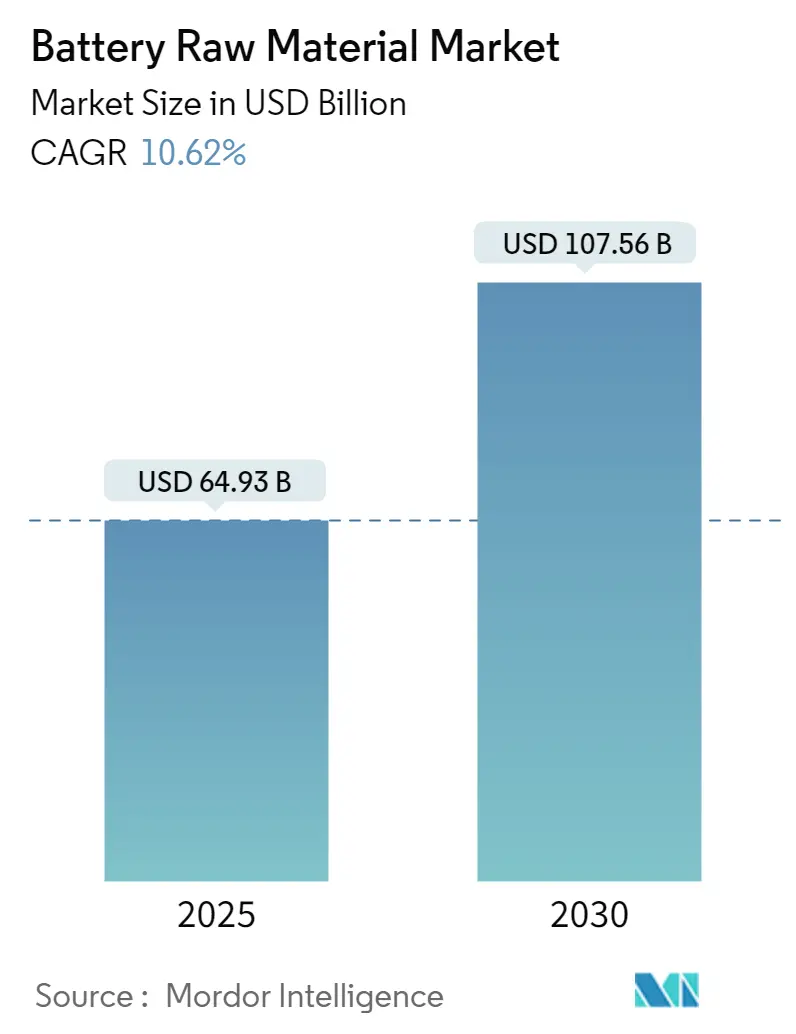
Battery Raw Material Market Analysis by Mordor Intelligence
The Battery Raw Material Market size is estimated at USD 64.93 billion in 2025, and is expected to reach USD 107.56 billion by 2030, at a CAGR of 10.62% during the forecast period (2025-2030).
The COVID-19 pandemic disrupted the battery materials market. Lockdown measures, factory closures, and restrictions on movement led to disruptions in mining operations, ore processing facilities, and logistics networks, impacting the supply of raw materials. The resumption of economic activities across industries, including automotive, electronics, and energy, contributed to the recovery of the battery raw materials market.
- The market for battery raw materials is proliferating due to the increasing use of these products in the automotive and consumer electronics sectors.
- However, the growth of the battery raw materials market is expected to be hampered by strict safety regulations for batteries through storage and transport.
- The rising research and development activities in vanadium flow technology and increasing demand for portable electronics and consumer devices are expected to provide opportunities for the battery raw material market in the coming years.
- The growing consumption of automotive and consumer electronics batteries in countries such as China and India is driving Asia-Pacific to dominate the global market.
Global Battery Raw Material Market Trends and Insights
Automotive Segment to Dominate the Market
- With the rapid rise in the adoption of electric vehicles, the car industry is undergoing a significant change. Various critical raw materials are required for the Lithium-ion battery, which is a crucial energy storage. As EV sales continue to surge globally, the demand for these battery raw materials has skyrocketed, driving growth in the automotive segment of the battery raw materials market.
- According to the estimate released by the International Organization of Motor Vehicle Manufacturers (OICA), around 81.63 million vehicles were sold around the world in 2022.
- Furthermore, according to the Federal Motor Transport Authority, Flensburg, the registration of the total number of battery electric cars in Germany increased from 136,617 units in 2020 to 1,013,009 units in 2023.
- In the consumer electronics and automotive sectors, Asia-Pacific countries such as China, Japan, South Korea, and India are experiencing strong growth in the use of battery raw materials, which is expected to drive the market over the forecast period.
- The expansion of EV charging infrastructure worldwide has bolstered consumer confidence in EVs and fueled the adoption of electric vehicles. Governments, utilities, and private companies are investing heavily in the deployment of charging stations, fast-charging networks, and smart grid technologies. Thus, this supports the growing fleet of EVs. This infrastructure development has created a robust market for battery raw materials to meet the increasing demand for lithium-ion batteries in automotive applications.
- According to the data published by the Federal Network Agency, in Germany, there were 87,155 public sites with average speed recharging for EVs available in October 2023 and 21,111 public quick charge stations.
- The increase in the adoption of electric vehicles aligns with the clean energy policy. The Chinese government intends to relax restrictions on the import of vehicles by automobile manufacturers into China in order to narrow the supply gap for demand.
- The market for battery materials is expected to be driven by all of the above factors during the forecast period.
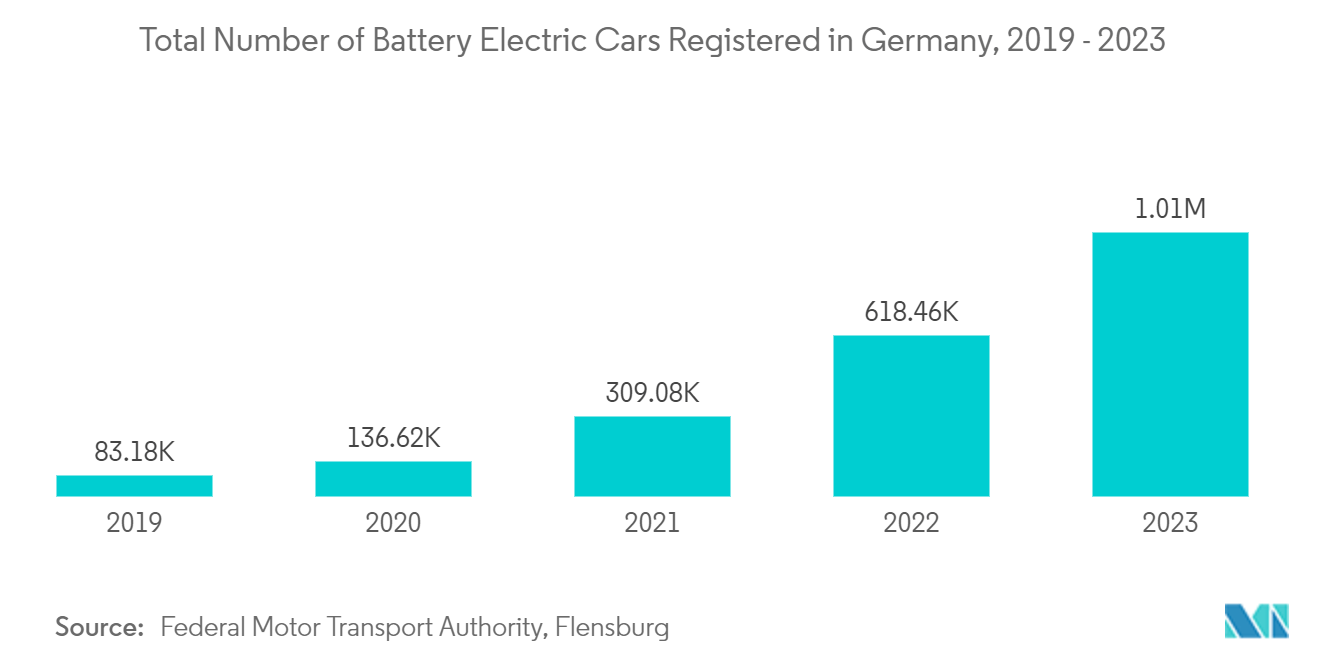
Asia-Pacific to Dominate the Market
- Asia-Pacific is an important manufacturing hub for a wide range of sectors, from automotive to electronics and renewables. The region hosts a large number of battery manufacturers, cell producers, and suppliers of battery raw materials. This concentration of manufacturing facilities drives demand for battery raw materials in Asia-Pacific.
- The Asia-Pacific market for electric vehicles is growing at a rapid rate in countries such as China, Japan, and South Korea. These countries are the biggest producers and consumers of electric vehicles in the world. The production of lithium-ion batteries for EVs requires significant quantities of battery raw materials such as lithium, cobalt, nickel, and graphite, contributing to the dominance of Asia-Pacific in the battery raw materials market.
- According to the data published by the China Association of Automobile Manufacturers (CAAM), in China, approximately 5.4 million battery electric vehicles were sold in 2022, an increase of 83,5 % compared to 2021. In the same year, there was an increase of 151.91% in sales of plugin hybrids to over 1.5 million vehicles in China from a year earlier.
- According to the data published by the Automobile Inspection & Registration Information Association, Japan (AIRIA), in 2023, the number of electric passenger cars in use in Japan increased to about 162.39 thousand vehicles, which was an increase from 10 years ago.
- In India, according to Vahan's data, EV sales in March 2023 increased by 82 % Y-o-Y, with 1,39,789 units sold compared to 77,128 EVs sold in March 2022. In total, sales increased by a staggering 157% in the period, from 4,58,746 to 11,80,597 during fiscal year 2022.
- Therefore, the demand for battery raw materials in the region during the forecast period is expected to be driven by all these market developments.
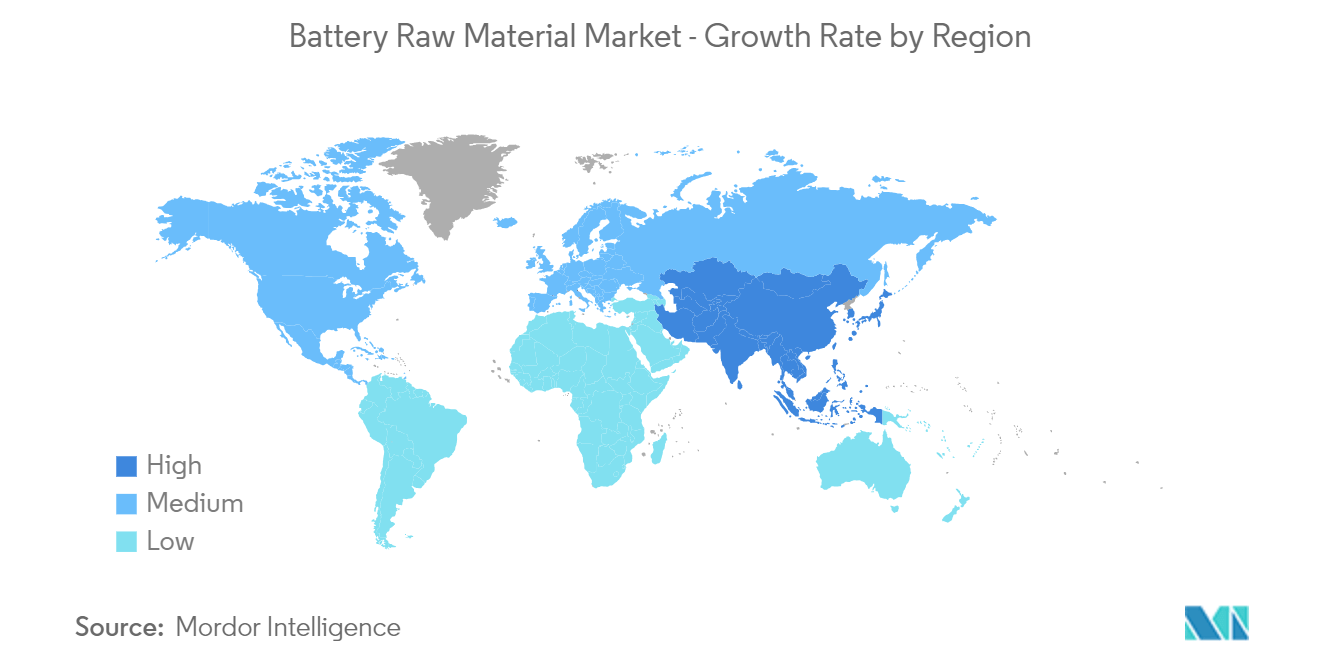
Competitive Landscape
The battery raw material market is fragmented, with the presence of a few large-sized players and a large number of small players operating. The major players (not in any particular order) include Umicore, Asahi Kasei Corporation, Johnson Matthey, Sumitomo Chemical Co. Ltd, and Mitsubishi Chemical Corporation.
Battery Raw Material Industry Leaders
-
Umicore
-
Asahi Kasei Corporation
-
Johnson Matthey
-
Sumitomo Chemical Co., Ltd.
-
Mitsubishi Chemical Corporation
- *Disclaimer: Major Players sorted in no particular order
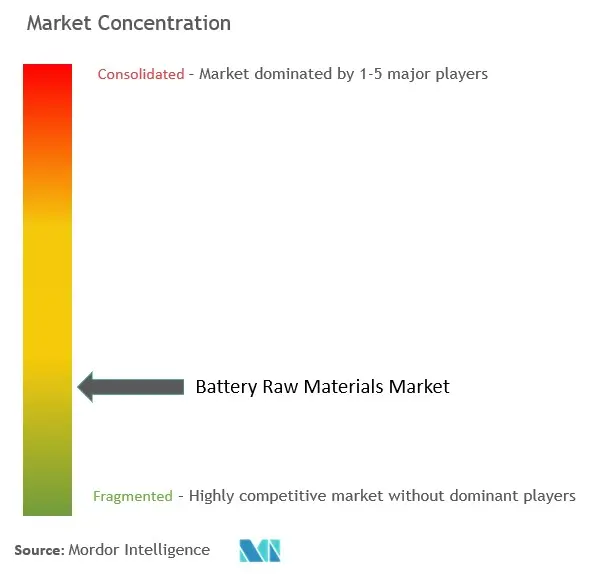
Recent Industry Developments
- January 2024: Iveco Group collaborated with BASF to provide a recycling solution for the lithium-ion batteries. This collaboration is intended to increase the lifetime of the batteries while decreasing their overall environmental impact.
- July 2023: Asahi Kasei licensed the design and manufacturing technology for lithium-ion capacitor. This doping method would enable LiCs to be manufactured at lower cost. This would also lead to increased capacity and improved input/output performance.
- March 2023: Celgard collaborated with C4V - lithium-ion battery technology company. Through this collaboration, the companies will develop the separator solutions for lithium-ion batteries. This will be further optimized for C4V's high-voltage bio-mineralized lithium mixed metal phosphate (BM-LMP) cathode material.
Global Battery Raw Material Market Report Scope
Battery raw materials refer to the primary elements and compounds used in the production of batteries. These materials are essential for manufacturing various types of batteries, including lithium-ion batteries, lead-acid batteries, and nickel-metal hydride batteries. The raw materials that are selected depend on the specific battery chemistry, performance requirements, and intended application.
The battery raw material market is segmented by battery type, material, application, and geography. By battery type, the market is segmented into lead-acid, lithium-ion, and other battery types (nickel-metal hydride (NiMH) and solid-state batteries). By material, the market is segmented into cathode, anode, electrolyte, and separator. By application, the market is segmented into consumer electronics, automotive, industrial, telecommunication, and other applications (renewable energy storage). The report also covers the market size and forecasts for the battery raw material market in 18 countries across major regions. For each segment, the market sizing and forecasts were made on the basis of value (USD).
| Lead-acid |
| Lithium-ion |
| Other Battery Types (Nickel-metal Hydride (NiMH), and Solid-state Batteries) |
| Cathode |
| Anode |
| Electrolyte |
| Separator |
| Consumer Electronics |
| Automotive |
| Industrial |
| Telecommunication |
| Other Applications (Renewable Energy Storage) |
| Asia-Pacific | China |
| India | |
| Japan | |
| South Korea | |
| Thailand | |
| Malaysia | |
| Indonesia | |
| Vietnam | |
| Rest of Asia-Pacific | |
| North America | United States |
| Canada | |
| Mexico | |
| Europe | Germany |
| United Kingdom | |
| France | |
| Italy | |
| Spain | |
| Turkey | |
| Russia | |
| NORDIC | |
| Rest of Europe | |
| Rest of the World | South America |
| Middle East and Africa |
| By Battery Type | Lead-acid | |
| Lithium-ion | ||
| Other Battery Types (Nickel-metal Hydride (NiMH), and Solid-state Batteries) | ||
| By Material | Cathode | |
| Anode | ||
| Electrolyte | ||
| Separator | ||
| By Application | Consumer Electronics | |
| Automotive | ||
| Industrial | ||
| Telecommunication | ||
| Other Applications (Renewable Energy Storage) | ||
| By Geography | Asia-Pacific | China |
| India | ||
| Japan | ||
| South Korea | ||
| Thailand | ||
| Malaysia | ||
| Indonesia | ||
| Vietnam | ||
| Rest of Asia-Pacific | ||
| North America | United States | |
| Canada | ||
| Mexico | ||
| Europe | Germany | |
| United Kingdom | ||
| France | ||
| Italy | ||
| Spain | ||
| Turkey | ||
| Russia | ||
| NORDIC | ||
| Rest of Europe | ||
| Rest of the World | South America | |
| Middle East and Africa | ||
Key Questions Answered in the Report
How big is the Battery Raw Material Market?
The Battery Raw Material Market size is expected to reach USD 64.93 billion in 2025 and grow at a CAGR of 10.62% to reach USD 107.56 billion by 2030.
What is the current Battery Raw Material Market size?
In 2025, the Battery Raw Material Market size is expected to reach USD 64.93 billion.
Who are the key players in Battery Raw Material Market?
Umicore, Asahi Kasei Corporation, Johnson Matthey, Sumitomo Chemical Co., Ltd. and Mitsubishi Chemical Corporation are the major companies operating in the Battery Raw Material Market.
Which is the fastest growing region in Battery Raw Material Market?
Asia Pacific is estimated to grow at the highest CAGR over the forecast period (2025-2030).
Which region has the biggest share in Battery Raw Material Market?
In 2025, the Asia Pacific accounts for the largest market share in Battery Raw Material Market.
What years does this Battery Raw Material Market cover, and what was the market size in 2024?
In 2024, the Battery Raw Material Market size was estimated at USD 58.03 billion. The report covers the Battery Raw Material Market historical market size for years: 2019, 2020, 2021, 2022, 2023 and 2024. The report also forecasts the Battery Raw Material Market size for years: 2025, 2026, 2027, 2028, 2029 and 2030.
Page last updated on:
Battery Raw Material Market Report
Statistics for the 2025 Battery Raw Material market share, size and revenue growth rate, created by Mordor Intelligence™ Industry Reports. Battery Raw Material analysis includes a market forecast outlook for 2025 to 2030 and historical overview. Get a sample of this industry analysis as a free report PDF download.
